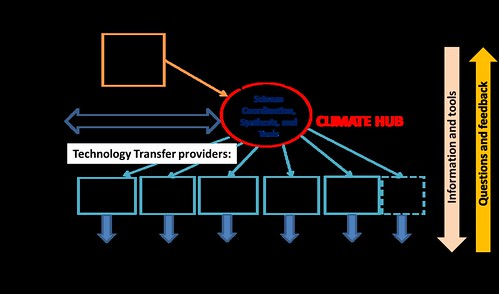The USDA Climate Hubs are almost one year old! Since February of 2014, we have made considerable progress by developing networks that connect researchers to landowners; by evaluating available tools that can help land managers with management decisions regarding risk management; by synthesizing regional risks and vulnerabilities; and we have learned a lot along the way.
The Hubs are about developing and delivering science-based, region-specific information and technologies, with the help of USDA agencies and partners, to agricultural and natural resource managers and communities. Land managers and communities desire healthy, resilient, productive, and profitable agricultural or natural ecosystems that are sustainable over time. The Hubs’ role is to work with (and as) advisers to land managers by providing information and tools to help them achieve their goals in an environment filled with climate-related stresses and risks. The Hubs’ initial focus is on communicating with our stakeholders and developing networks with our partners. This includes communicating research to Certified Crop Advisors, relaying stakeholder needs to science organizations, or just making sure the lines of communication are open among the respective science and information providers and managers of working lands.
As part of our mission, we work with our USDA agencies and partners (e.g., Cooperative Extension, certified crop advisors, universities, federal agencies) to deliver science-based, region-specific information and tools to farmers, ranchers and forest land owners to enable them to make wise risk-management decisions. With regard to a variable climate, the risks/stressors include drought, floods, extreme weather events, increased pests, diseases and forest fires, and changing growing seasons.
While there are a number of networks providing research and information to managers, none focus on the working land mangers – those that produce our nation’s food, fiber, and forest products every day. That’s why we need the Hubs. They work with other Federal climate networks (National Oceanic and Atmospheric Administration (NOAA) Regional Integrated Sciences and Assessments (RISA) program, U.S. Geological Survey Climate Science Centers, Fish and Wildlife Service Landscape Conservation Cooperatives, NOAA Regional Climate Centers, and others) to make science available to managers over a broad range of sectors. The different networks work together to coordinate and complement each other’s efforts. While considerable research examines the impacts and risks associated with climate variability, only a small percentage of this research is in a form that a land manager can use. The Hubs were formed to help transform complex research results into easily accessible products and then to provide these products to land managers.

We do this through partnerships. There are a number of organizations and programs that already do some of the activities the Hubs hope to accomplish. Keys to the hub’s success include: 1) establishing partnerships with existing research and outreach organizations, 2) coordinating USDA climate-related efforts, and 3) establishing a pathway that runs from the researcher to the land manager and back.
The Hubs are being designed to facilitate communication between research and landowners. This two-way “conversation” brings research to the landowner and also brings input back to the research community regarding the usefulness of the tools and information being provided and the unmet needs that require additional research and tool development.
USDA funds foundational and applied research that examines vulnerabilities and risks to agriculture and forestry. The purpose of this research is to understand climate-induced risks, and to develop management solutions to deal with drought, flooding, pest pressures, forest fires, altered water availability, changing growing seasons and other stressors. The Hubs take advantage of all available research and will leverage existing results that can contribute to our mission. Our role is also to inform research organizations (USDA and others) of landowner concerns so that research can address priority needs. This feedback will come from our interactions with landowners, landowner organizations, and our partners.
Often, packaging research is the bottleneck in moving science to the land owner. For the agriculture sector, the State Agricultural Experiment Stations are primary producers of useable science information and tools, and are important partners in this effort. The USDA National Institute of Food and Agriculture’s (NIFA) Coordinated Agricultural Projects (CAP) support large-scale regional projects that also provide tools and information for land owners. Other organizations, such as NOAA RISAs and the Nature Conservancy, also develop tools, and we are trying to evaluate all the available tools we can find and make them available on our web site.
Land managers often depend on trusted advisors to supply them with the information they need to find solutions to challenges they are facing. It’s that person-to-person contact that drives changes to land management practices. While the Hubs do reach out to land owners directly, the major way we will engage landowners on a person-to-person basis is to capitalize on existing networks. Two primary networks are Cooperative Extension and the USDA Service Centers. These organizations have been helping farmers, ranchers and forest land managers for decades (100 years for Cooperative Extension!). On the forestry side, the Forest Service Threat Centers and the Climate Change Response Framework provide outreach to forest land managers.
So what’s next? This first year has been more about coordination than production. It is crucial that we understand all the players in the game so that we can concentrate on areas and projects that will have the greatest impact on providing risk-management tools and resources to America’s farmers, ranchers and forest land owners. This requires that we coordinate with other research organizations, work closely with Cooperative Extension and the USDA Service Centers to understand their needs, and also to establish a working relationship with those private advisors that work with landowners (see figure below). These private advisors include the Certified Crop Advisors (CCAs), forestry consultants, and seed and fertilizer dealers. By better understanding the needs of the agricultural community and documenting the currently available resources we can prioritize the gaps in the research-to-field supply chain and more effectively direct USDA resources to help the Nation’s farmers, ranchers, and forest land owners.

